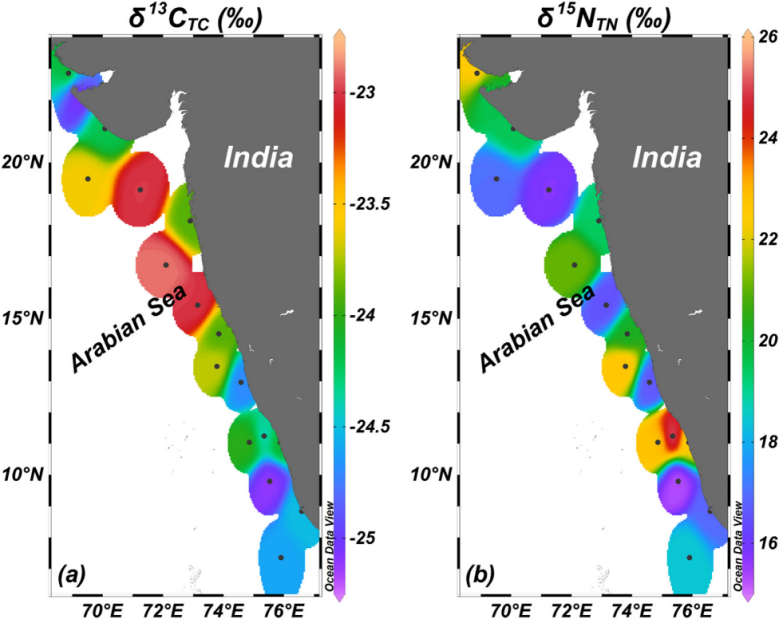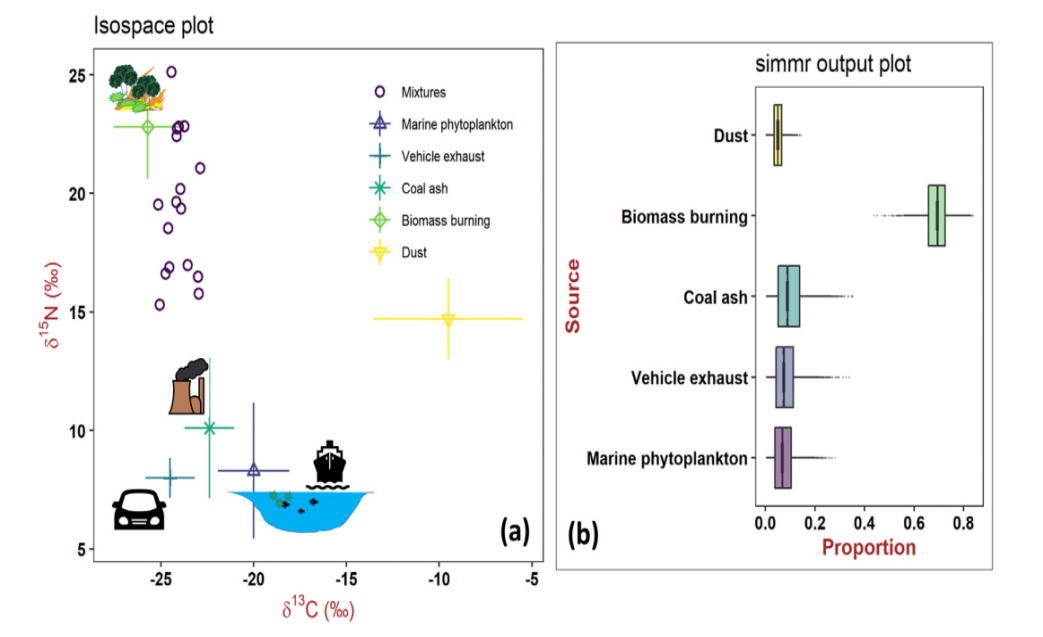有机气溶胶(OA)是大气颗粒物的主要成分,对区域和全球气候存在直接(即散射/吸收)和/或间接(如吸湿性、云层沉降核)影响。全球大气中OA来源除了包括生物质燃烧/生物排放和化石燃料燃烧直接排放外,还包括二次气溶胶形成过程中的挥发或半挥发性有机化合物形成的OA。理清OA的来源及其在长距离传输过程中不断变化的特征,有利于准确预测其对大气层辐射强迫的影响。
Organic aerosols (OA), a major component of atmospheric particulate matter, influence regional and global climate via the direct (i.e., scattering/absorption) and/or indirect effects (e.g. hygroscopicity, cloud condensation nuclei). The major sources of OA over the continents include biomass burning/biogenic emissions and fossil-fuel combustion. Apart from the direct emissions, secondary formation processes involving the condensation of semi-volatile organic compounds (SVOC) also contribute to OA abundances. It is important to understand the evolving characteristics of OA during long-range transport to accurately predict their overall effect on atmospheric radiative forcing.
受到印度恒河平原(IGP)和印度南部污染物的大气长距离传输的影响,从南亚传出的雾霾污染会明显影响阿拉伯海的海洋大气边界层气溶胶的化学成分。以往研究证明,大气气溶胶中总碳(TC)和总氮(TN)的稳定碳(δ13CTC)和氮(δ15NTN)同位素组成可用于探究OA的来源和形成过程。
Influenced by the long-range atmospheric transport of pollutants in the Indo-Gangetic Plain (IGP) and southern India, the haze pollutants transported from South Asia significantly affect the chemical composition of marine atmospheric boundary layer of the Arabian Sea.According to previous research, the concentrations of total carbon (TC) and total nitrogen (TN) along with their stable carbon and nitrogen isotopic compositions (δ13CTCand δ15NTN, respectively) in atmospheric aerosol can be used toexplorethe sources and formation processes of OA.

图1.阿拉伯海上空气溶胶来源示意图
Fig. 1. Schematic diagram of the sources of aerosols over the Arabian Sea
2018年,印度国家海洋学研究所的Bikkina等人测量了冬季12月6日至12月25日在阿拉伯海上空采集的TSP样本的总碳(TC)和总氮(TN)的浓度以及δ13CTC和δ15NTN,结合了混合单粒子拉格朗日轨迹(HYSPLIT)模型及中尺度分辨率成像分光仪(MODIS)卫星检索到的火灾数量用于气团输送分析。结果显示IGP西北部和印度南部的作物残留物的露天焚烧行为对大气中的TC和TN气溶胶产生了显著影响(图2)。
In 2018, Bikkina et al. of the National Institute of Oceanography, India, measured total carbon (TC) and total nitrogen (TN) concentrations as well as δ13CTCand δ15NTNin TSP samples collected over the Arabian Sea during the winter season from December 6 to December 25, combining the Hybrid Single Particle Lagrangian Trajectory (HYSPLIT) model and the number of fires retrieved by the Moderate Resolution Imaging Spectroradiometer (MODIS) satellite for air mass transport analysis.The results show that open burning practices of crop residues in the northwestern IGP and southern India significantly influenced the atmospheric TC and TN aerosols during the SS379 cruise.

图2阿拉伯海上空收集的TSP的巡航轨迹和后向气团轨迹,大陆上的红点是卫星检索到的火灾数量。
Fig. 2. Cruise track and backward air mass trajectories of TSP collected over the Arabian Sea, and the red dots on the continent is the fire counts retrieved from the moderate resolution imaging spectroradiometer (MODIS) satellite.
阿拉伯海上空采集的TSP样品的δ13CTC变化范围为-25.1‰~-22.9‰(平均-24.0±0.7‰;图3a),该值低于开阔海洋的大气颗粒有机物的δ13CTC值(平均-21±2‰),暗示南亚排放对阿拉伯海气溶胶δ13CTC值的影响。阿拉伯海上空采集的气溶胶样品的δ15NTN的变化范围为+15.3‰~+25.1‰(平均为+19.5±2.1‰)(图3b),该值与东南亚上空的生物质燃烧排放颗粒物的δ15NTN值(范围:+15.8至+25.1‰;平均+19.4±2.1‰)一致,表明东南亚的生物质燃烧排放对阿拉伯海气溶胶TN的影响。
The δ13CTCof TSP samples collected over the Arabian Sea varied from −25.1‰ to −22.9‰ (−24.0 ± 0.7‰; Fig. 3a). These values are significantly lower than those documented for the airborne particulate organic matter from the remote oceans (−21 ± 2‰). This result suggests that the source-emissions from South Asia significantly influence the measured δ13CTCsignatures over the Arabian Sea during the winter cruise. The δ15NTNin marine aerosols collected over the Arabian Sea during the winter cruise varied from +15.3‰ to 25.1‰ with an average of +19.5 ± 2.1‰ (Fig. 3b), which shows remarkable consistency with the biomass burning emissions (range: +15.8 to +25.1‰; av. +19.4 ± 2.1‰) sampled over Southeast Asia. All the evidence shows that the biomass burning emissions in Southeast Asia have impacts on aerosols over Arabian Sea.

图3在阿拉伯海上空收集的海洋气溶胶中,(a)TC的稳定碳同位素组成(δ13CTC)和(b)TN的氮同位素组成(δ15NTN)的空间变化。
Fig. 4. Spatial variability of (a) stable carbon isotopic composition of TC (δ13CTC), and (b) nitrogen isotopic composition of TN (δ15NTN) in marine aerosols collected over the Arabian Sea.
研究者将阿拉伯海采集的颗粒物样本与各种排放源的δ13CTC和δ15NTN值进行比较来进一步解析阿拉伯海OA的可能来源以及它们在大陆传输期间与无机气溶胶成分的混合(图4a)。图4a中δ13C-δ15N的双同位素显示,阿拉伯海上空气溶胶TC和TN的主要源是南亚的生物质燃烧和燃煤电厂。研究者还结合不同排放源的δ13C和δ15N值和贝叶斯混合模型(SIAR)定量估算了不同排放源对阿拉伯海气溶胶有机物的贡献。结果显示C3生物质燃烧(69±5%)和燃煤电厂(10±6%)是阿拉伯海OA的主要来源。大陆其他来源(如灰尘:5±2%)和海洋来源(即浮游植物渗出物或来自海洋的相关有机物:8±5%)对阿拉伯海OA的贡献较小(图4b)。
Researchers have compared the δ13CTCand δ15NTNin the air over the Arabian Sea with those relevant for the source emissions to underpin the possible sources of organic aerosols and their mixing with the inorganic aerosol components during continental outflow (Fig. 4a). The dual isotopes of δ13C-δ15N in Figure 4a show that the main sources of aerosol TC and TN over the Arabian Sea are biomass burning and coal-fired power plants in South Asia. Furthermore, researchers have employed a Bayesian approach based stable isotope-mixing model to assess the proportional contribution of TC and TN from various source-emissions in marine aerosols collected over the Arabian Sea. Results show that C3biomass burning (69 ± 5%) and coal fired power plants (10 ± 6%) are the major sources of OA over the Arabian Sea. All other continental (e.g., dust: 5 ± 2%) and marine sources (i.e., phytoplankton exudates or related organic matter from seas: 8 ± 5%) are only minor components (Fig. 4b).

图4(a)阿拉伯海海洋气溶胶中TC和TN的δ13C与δ15N的双同位素空间图,以及源排放成分;(b)使用贝叶斯同位素混合模型对阿拉伯海的总体单个源排放贡献。
Fig. 4. Dual isotope spatial maps of δ13C and δ15N for TC and TN in Arabian Sea marine aerosols, and source emission components, (b) overall individual source emission contributions over the Arabian Sea using Bayesian isotope mixing model.
参考文献:DOI: 10.1016/j.scitotenv.2022.154260